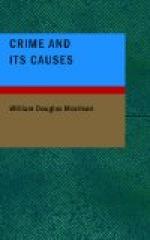The peculiar structure of society is unquestionably the most satisfactory explanation of the high position occupied by the inhabitants of India with respect to crime. The social edifice which a people builds for itself is among all civilised communities a highly complex product, and consists of a great agglomeration of diverse materials. These materials are partly drawn from the primitive characteristics of the race; they are partly borrowings from other and contiguous races; they are to a considerable extent derived from natural surroundings of all kinds; and in all circumstances they are supplemented by the genius of individuals. In short, all social structures, when looked at minutely, are found to be composed of two main ingredients—race and environment; but these two ingredients are so indissolubly interfused that it is impossible to say how much is to be attributed to the one, and how much to the other, in the building up of a society. But if, it is impossible to estimate the value of the several elements composing the fabric of society, it is easy to ascertain the dominating idea on which all forms of society are based. That dominating idea, if it may for the moment be called such, is the instinct of self-preservation, and it exercises just as great a power in determining the formation and play of the social organism as it exercises in determining the attitude of the individual to the world around him. In working out the idea of self-preservation into practical forms, the social system of most peoples has hitherto been built up with a view to protection against external enemies in the shape of hostile tribes and nations; the internal enemies of the commonwealth—the thieves, the housebreakers, the disturbers of public order, the shedders of blood, the perpetrators of violence—have been treated as only worthy of secondary consideration. Such are the lines on which social structure has, in most cases, proceeded, with the result that while external security was for long periods assured, internal security remained as imperfect and defective as ever.




